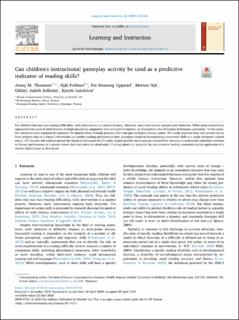| dc.contributor.author | Thomson, Jennifer Marie | |
| dc.contributor.author | Foldnes, Njål | |
| dc.contributor.author | Uppstad, Per Henning | |
| dc.contributor.author | Njå, Morten Bergsten | |
| dc.contributor.author | Solheim, Oddny Judith | |
| dc.contributor.author | Lundetræ, Kjersti | |
| dc.date.accessioned | 2023-02-08T08:15:50Z | |
| dc.date.available | 2023-02-08T08:15:50Z | |
| dc.date.created | 2020-07-16T10:15:36Z | |
| dc.date.issued | 2020 | |
| dc.identifier.citation | Thomson, J. M., Foldnes, N., Uppstad, P. H., Njå, M., Solheim, O. J., & Lundetræ, K. (2020). Can children's instructional gameplay activity be used as a predictive indicator of reading skills?. Learning and Instruction, 68, 101348. | en_US |
| dc.identifier.issn | 0959-4752 | |
| dc.identifier.uri | https://hdl.handle.net/11250/3049099 | |
| dc.description.abstract | For children who may face reading difficulties, early intervention is a societal priority. However, early intervention requires early detection. While much research has approached the issue of identification through measuring component skills at single timepoints, an alternative is the utilisation of dynamic assessment. To this point, few initiatives have explored the potential for identification through progress data from play in digital literacy games. This study explored how well growth curves from progress data in a digital intervention can predict reading performance after gameplay compared to measuring component skills at a single timepoint (school entry). 137 six-year-old students played the digital Graphogame for 25 weeks. Latent growth curve analyses showed that variation in trajectories explained variation in literacy performance to a greater extent than risk status at school entry. Findings point to a potential for non-intrusive reading assessment in the application of a serious digital game in first grade. | en_US |
| dc.language.iso | eng | en_US |
| dc.publisher | Elsevier | en_US |
| dc.rights | Navngivelse 4.0 Internasjonal | * |
| dc.rights.uri | http://creativecommons.org/licenses/by/4.0/deed.no | * |
| dc.title | Can children's instructional gameplay activity be used as a predictive indicator of reading skills? | en_US |
| dc.type | Peer reviewed | en_US |
| dc.type | Journal article | en_US |
| dc.description.version | publishedVersion | en_US |
| dc.rights.holder | The authors | en_US |
| dc.subject.nsi | VDP::Samfunnsvitenskap: 200::Pedagogiske fag: 280 | en_US |
| dc.source.pagenumber | 0 | en_US |
| dc.source.volume | 68 | en_US |
| dc.source.journal | Learning and Instruction | en_US |
| dc.identifier.doi | 10.1016/j.learninstruc.2020.101348 | |
| dc.identifier.cristin | 1819555 | |
| cristin.ispublished | true | |
| cristin.fulltext | original | |
| cristin.qualitycode | 2 | |

